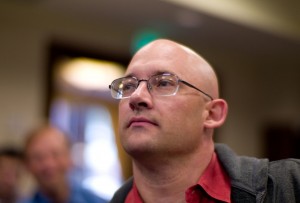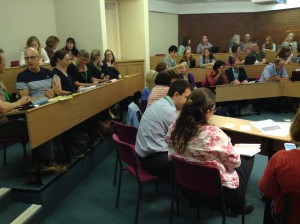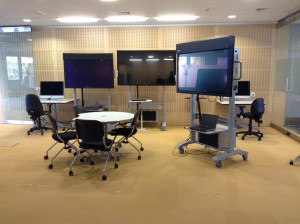Last month, I attended my first conference for the Association of Learning Technologists (ALTc), held at the University of Warwick. Not only was it my first ALTc, but probably also the first time to significantly engage with the wider community of learning technologists working in higher education (HE), at least since joining City. Following are ten moments and observations from the conference.
1. MOOCs are still a big deal
In 2012, NYU professor and renowned Internet thinker Clay Shirky claimed that the ‘MOOC is our mp3’, meaning that massive open online courses had the same capacity to disrupt HE as Napster and the rise of the mp3 had had on the music industry. Two years on, it is clear that while there are more critical and even cynical perspectives on MOOCs around now, they are still very much en vogue. At least 10 sessions had MOOC in the title, many other sessions referenced them, and even the opening keynote situated itself ‘as the hype around MOOCs settles’.
2. Reclaiming the Luddites
In a fascinating keynote address from educational technology writer Audrey Watters titled ‘Ed Tech, Frankenstein’s Monster and Teacher Machines’, we saw an unexpected reappraising of the Luddites. Renowned for loom smashing during the early industrial revolution, Watters indicated that the original Luddites, despite longstanding historical perceptions to the contrary, were not against technology per se but against notions of technological progress that, as part of a new market system, would make their lives worse rather than better. Interesting.
Further reading from the ALTs tweetstream on this subject during her address threw up articles by Thomas Pynchon, the National Archives and Hybrid Pedagogy.
3. Wales goes OER
Along with MOOCs, there was plenty of talk about ‘openness’, including around Open Educational Resources (OER). Having incorporated the concept into an MA dissertation in 2013, I was keen to explore this notion further and attended an OER Special Interest Group (OERSIG). Here, I found out that in September 2013, Wales became the first nation to embed the concept of ‘Open Education’ within a national strategy. This meant that 12 universities signed a public declaration of intent that committed them to innovation and increasing access to HE via the use of OER. The 2015 UK OER conference is to be held in Cardiff.
An interesting move to make in the post-MOOC landscape.
4. Plenty of nice ideas for slide design
I’m a big fan of good slide design in presentations, believing that simple is generally best. Slides are there to help an audience listen rather than to give them the same text to read that the speaker’s talking about. Keynotes by Catherine Cronin and Audrey Watters illustrated this nicely with slides of well-chosen pictures only. Bryan Mathers took the novel approach of hand-drawn slides, which was very effective. Naturally, there were also plenty of drab or overloaded ones with too little thought or too much text, as will be present at any conference.
Good slide design can be such a fine art to get right, so it’s good to learn from those that do.
5. The jury remains out on using Twitter in classroom
The conference had a very lively Twitter backchannel, with almost twice as many ALTc-related tweets being sent than each of the previous five conferences. This meant significant online engagement with many of the conference sessions, but also a lot of ‘heads down’ everywhere.
Two presentations highlighted the divide is the use of Twitter as a classroom tool too. Stefano de Paoli noted that ‘the most significant aspect of using Twitter in the classroom is dealing with the problems’, claiming that the problems were never discussed in the literature. These problems could be technological, architectural, social or system-related. A. G. Pate, on the other hand, described how his students experienced greater engagement, deeper reflection and supported each others’ learning more by using the tool. Pate’s presentation on tweeting during lectures and tutorials can be found here.
6. Lecture capture embedded at Imperial/UCL
In asking ‘Does institutional lecture capture improve student learning?’, a joint presentation from Imperial College and UCL aimed to address cynicism about lecture capture. They spoke of a three-year study across the two institutions, concluding that it contributed to student engagement with subject, better retention and more enthusiasm/interest in subject, and well as boosting lecturer engagement with students and their learning needs. Commenting that a ‘good way to think about lecture capture is as a gateway to other forms to teaching and learning’, this session also highlighted the REC:all project, a transnational project for exploring how lecture capture can be made more pedagogically valuable and engaging.
7. The Learning Technologies community is small but very engaged
People seem to come to learning/educational technologist roles via a range of routes. My route included being a teacher using learning technologies in my classes, then as a corporate IT trainer for an international education provider. I was struck that, although the LT community is reasonably small – there were 450 delegates at this annual gathering for the community – it seems to be nevertheless highly engaged, with people being very supportive of each other.
8. Seamless Learning
I discovered a new term/buzz phrase on a visit to one of Warwick’s experimental teaching spaces – Seamless Learning. While there seem to be a range of definitions available, the OU’s description of ‘connecting learning experiences across the contexts of location, time, device and social setting’ seems appropriately descriptive.
9. iPad coffee club
Following on from the simplicity in certain slide designs, I also came across a couple of nicely simple ideas for creatively solving particular problems. One such solution was the iPad coffee club run by Olaojo Alyegbayo at Huddersfield University (and inspired by a similar venture in Southampton). Once a week, academics share tips and challenges on their use of tablets in their teaching, in an unpressured and informal environment, with coffee and cake. The facilitator is seen as a ‘knowledgeable enthusiast’ rather than an ‘expert’. Staff use either their own or loaned devices, which are not limited to iPads. ALTc session slides are here with a fuller project write-up here.
10. QR codes in non-standard teaching spaces
Another great simple idea came from the University of Manchester, where QR codes had been deployed across sewing labs to facilitate a route to answering the large number of low-level, easy-to-resolve student questions that often take up plenty of time. This allowed for the technicalities of the machinery used in these labs to be embedded online, thus freeing up higher level learning in face-to-face time between the academic and their learners.
Click here for a useful guide to the use of QR codes in education.







Leave a Reply